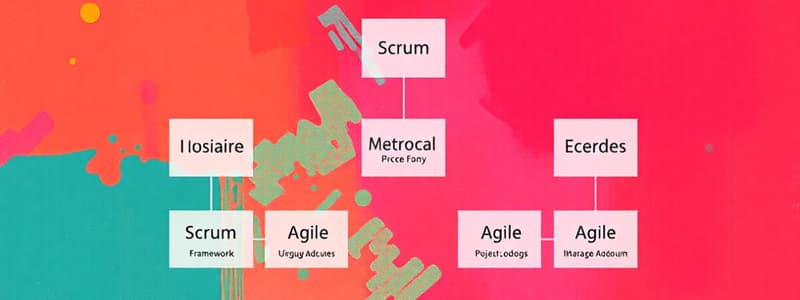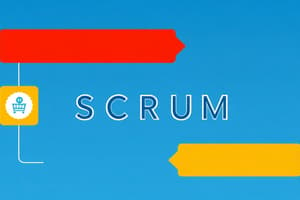Podcast
Questions and Answers
What is the primary purpose of the Daily Scrum meeting?
What is the primary purpose of the Daily Scrum meeting?
- To plan the next Sprint activities
- To solve detailed problems in project development
- To showcase the Product Increment to stakeholders
- To determine the current state of the Development Work (correct)
Which of the following best describes the Sprint Review?
Which of the following best describes the Sprint Review?
- A session to gather user feedback on the initial product design
- A ceremony where the Product Increment is demonstrated (correct)
- An assessment of team performance over multiple Sprints
- A meeting conducted at the beginning of the Sprint to plan tasks
During which meeting does the Scrum Team discuss improvements for the next Sprint?
During which meeting does the Scrum Team discuss improvements for the next Sprint?
- Sprint Planning
- Sprint Retrospective (correct)
- Daily Scrum
- Sprint Review
What is represented by the Burndown Chart?
What is represented by the Burndown Chart?
How is Development Work primarily organized during a Sprint?
How is Development Work primarily organized during a Sprint?
Which statement about Scrum teams is accurate?
Which statement about Scrum teams is accurate?
Which of the following is a key characteristic of Agile Project Management in comparison to traditional management?
Which of the following is a key characteristic of Agile Project Management in comparison to traditional management?
What is included in a user story as demonstrated in the example for the ABC company?
What is included in a user story as demonstrated in the example for the ABC company?
What happens as a result of completing items in the Sprint Backlog?
What happens as a result of completing items in the Sprint Backlog?
Which approach is more suitable for projects requiring extensive procurement of goods?
Which approach is more suitable for projects requiring extensive procurement of goods?
What is the primary focus of this chapter regarding Agile project management?
What is the primary focus of this chapter regarding Agile project management?
Which of the following accurately describes a Sprint in the Scrum framework?
Which of the following accurately describes a Sprint in the Scrum framework?
Which of the following is NOT a component of a Sprint according to the Scrum framework?
Which of the following is NOT a component of a Sprint according to the Scrum framework?
Who is responsible for ensuring that the Scrum processes are followed within the Scrum Team?
Who is responsible for ensuring that the Scrum processes are followed within the Scrum Team?
During which meeting are user stories considered for inclusion in the current Sprint?
During which meeting are user stories considered for inclusion in the current Sprint?
What is the purpose of user stories in Agile project management?
What is the purpose of user stories in Agile project management?
Which technique may be used by the Development Team to estimate the amount of work to be completed during a Sprint?
Which technique may be used by the Development Team to estimate the amount of work to be completed during a Sprint?
Which role represents the organization in the Scrum Team?
Which role represents the organization in the Scrum Team?
What are Epics in the context of Agile project management?
What are Epics in the context of Agile project management?
What is the outcome of placing user stories in the Sprint Backlog?
What is the outcome of placing user stories in the Sprint Backlog?
Flashcards are hidden until you start studying
Study Notes
Introduction to Agile Delivery
- Traditional project management methodologies, such as Waterfall, may not be effective for projects involving rapid change and innovation, particularly in the software development domain.
- Agile methodologies address this by incorporating flexibility, iterative development, and collaboration.
- This course focuses on the Scrum framework as a leading Agile approach.
The Scrum Framework
- The Scrum framework involves iterations called Sprints, which typically last one to four weeks.
- Each Sprint consists of distinct phases: Sprint Planning, Development Work (including Daily Scrums), Sprint Review, and Sprint Retrospective.
Scrum Team
- The Scrum Team comprises three key roles:
- Product Owner: Represents the organization and prioritizes the Product Backlog.
- Development Team: Executes the Sprint work and is responsible for delivering the Product Increment.
- Scrum Master: Ensures Scrum processes are followed and facilitates the team.
Sprint Planning
- A meeting at the start of each Sprint to select User Stories from the Product Backlog for inclusion in the Sprint.
- User Stories are high-level descriptions of desired features, using the format "As a [User Role], I want to [Feature], so that [Benefit]". For example, "As a customer, I want to see a graphic of my monthly spending, so that I can manage my budget better".
- Epics are collections of related User Stories that represent larger projects or campaigns.
- The Development Team estimates the effort required for each User Story.
- User Stories chosen for the Sprint are added to the Sprint Backlog, forming the Sprint Goal.
Development Work
- The majority of the Sprint is dedicated to development work.
- The Development Team works self-directedly, tracking progress on a Scrum Board (typically a physical board with "To-Do", "Doing", and "Done" columns).
- The Burndown Chart visually represents the remaining work in the Sprint.
- The team's Velocity (measure of work completed) is calculated based on the points or days of work completed.
- The completed items from the Sprint Backlog constitute the Product Increment, a potentially shippable version of the product.
Daily Scrum
- A 15-minute daily meeting held at the same time each day, without chairs.
- Focuses on identifying the current state of the Development Work, not solving complex problems.
Sprint Review
- A meeting held at the end of the Sprint to demonstrate the completed Product Increment.
- The Product Increment should be in a state ready for potential release to customers.
- The Scrum Team and other stakeholders attend this meeting.
Sprint Retrospective
- A meeting held after the Sprint Review to reflect on what went well, what did not go well, and how processes can be improved for the next Sprint.
- It serves as an opportunity for ongoing process improvement and learning.
Comparison of Waterfall and Agile
-
Management Support: Agile PM relies on self-directed teams with management support, but without interference.
-
Planning: Agile PM uses an adaptive approach, responding to new information and conditions, unlike the predictive nature of Waterfall.
-
Project Team: Scrum teams are full-time and cross-functional, while Waterfall teams may have more specialized roles.
-
Quality and Risk: Agile methods emphasize continuous integration and feedback, potentially leading to improved quality and faster identification of risks.
-
Stakeholder Communication: Agile promotes frequent communication and collaboration, compared to traditional project management methods.
-
Project Procurement: Traditional project management may be more suitable for projects requiring procurement of goods.
-
Depending on the customer's requirements, a Waterfall, Agile, or hybrid approach may be most appropriate.
Studying That Suits You
Use AI to generate personalized quizzes and flashcards to suit your learning preferences.




